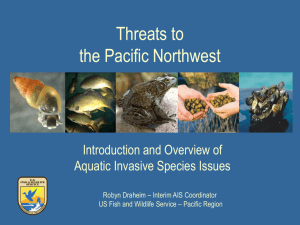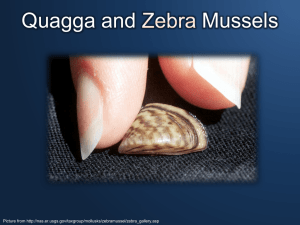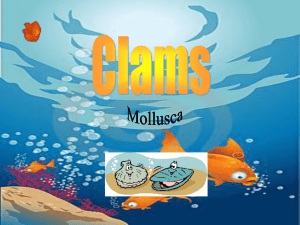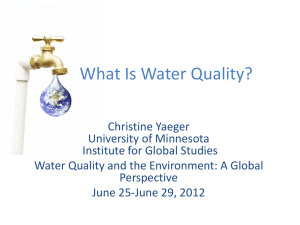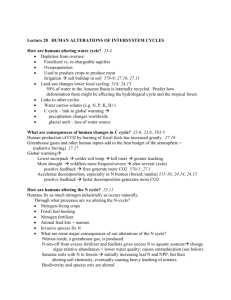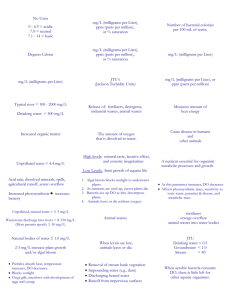Chapter 1: Evaluation of the toxicity of Virkon® Aquatic against two
advertisement
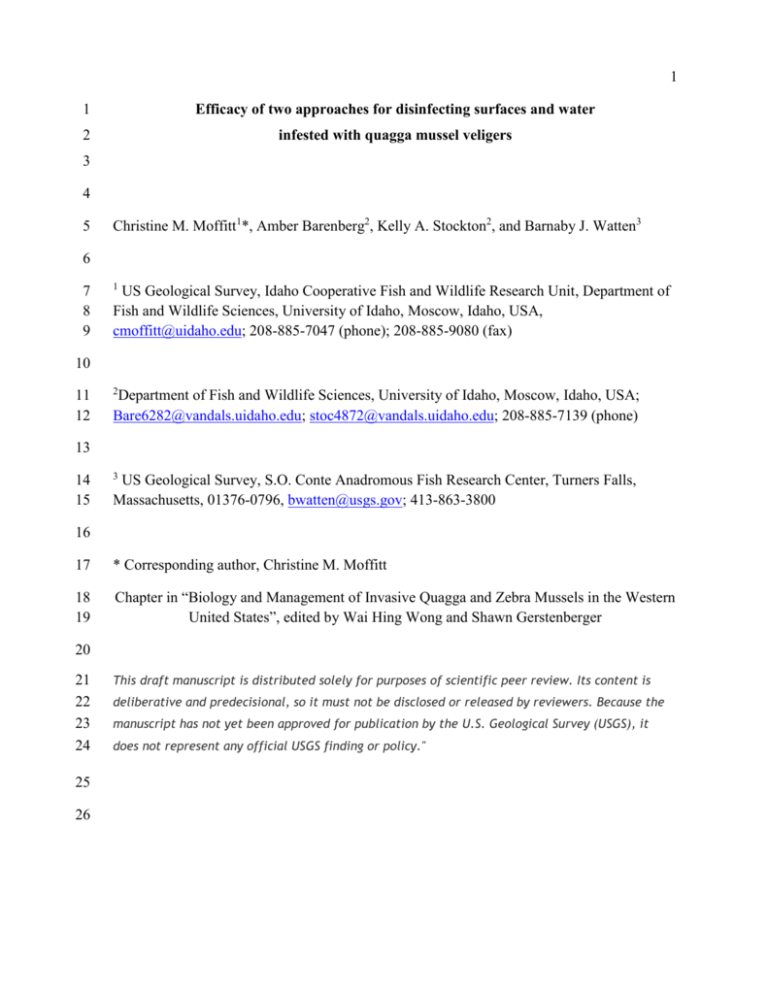
1 1 Efficacy of two approaches for disinfecting surfaces and water 2 infested with quagga mussel veligers 3 4 5 Christine M. Moffitt1*, Amber Barenberg2, Kelly A. Stockton2, and Barnaby J. Watten3 6 7 8 9 1 US Geological Survey, Idaho Cooperative Fish and Wildlife Research Unit, Department of Fish and Wildlife Sciences, University of Idaho, Moscow, Idaho, USA, cmoffitt@uidaho.edu; 208-885-7047 (phone); 208-885-9080 (fax) 10 11 12 2 Department of Fish and Wildlife Sciences, University of Idaho, Moscow, Idaho, USA; Bare6282@vandals.uidaho.edu; stoc4872@vandals.uidaho.edu; 208-885-7139 (phone) 13 14 15 3 US Geological Survey, S.O. Conte Anadromous Fish Research Center, Turners Falls, Massachusetts, 01376-0796, bwatten@usgs.gov; 413-863-3800 16 17 * Corresponding author, Christine M. Moffitt 18 19 Chapter in “Biology and Management of Invasive Quagga and Zebra Mussels in the Western United States”, edited by Wai Hing Wong and Shawn Gerstenberger 20 21 22 23 24 25 26 This draft manuscript is distributed solely for purposes of scientific peer review. Its content is deliberative and predecisional, so it must not be disclosed or released by reviewers. Because the manuscript has not yet been approved for publication by the U.S. Geological Survey (USGS), it does not represent any official USGS finding or policy." 27 Abstract 28 Disinfection tools and protocols are needed to meet an array of applications to reduce the 29 probability of transferring invasive mollusk species as hitchhikers. Applications include 30 rapid disinfection of recreational equipment and boats, to disinfecting water and equipment 31 used in fire suppression, to tools safe for hatchery and aquaculture operations. In replicated 32 laboratory trials, we tested the lethality of concentrations of three chemical solutions on 33 quagga mussel veligers (Dreissena rostriformis bugensis). Aqueous solutions of pH 12 were 34 created with NaOH or Ca(OH)2 and tested at 15 and 22°C and three aqueous concentrations 35 of Virkon® Aquatic were tested at 22°C. We observed mortality of veligers was faster in 36 warmer temperatures and in solutions of Ca(OH)2. We observed complete mortality in 37 solutions prepared with Ca(OH)2 within 10 min of exposure, and within 30 min of exposure 38 in solutions prepared with NaOH. We found solutions of 5 g/L of Virkon® Aquatic, used as 39 a disinfectant in aquaculture operations, killed all veligers within a 10 min exposure. We 40 conclude that all chemicals show promise as disinfectants, and use of Ca(OH)2 or NaOH to 41 elevate the pH of disinfecting solutions may provide an economical and environmentally 42 acceptable way to disinfect large surfaces or tanks. 43 44 45 46 Introduction 47 Global transportation of commodities and human movements pose challenges to natural 48 resource managers, as the risks of transporting alien organisms are compounded with each 49 vehicle and vector. In addition, many altered ecosystems are more vulnerable to invasion. 50 Among the highly successful invader alien organism are the mollusks, as they are armored 51 with shells that protect them from desiccation, and have great capacity to be considered as 52 engineers of systems in which they establish. Many vectors and vehicles including, fish, birds 53 and mammals, aquarium traders, ship ballast water, recreationalists, agency personnel, and 54 other water users can distribute invasive mollusks to new locations (Bowler 1991; Alanso 55 and Castro-Diez 2008; Bruce and Moffitt 2010). 56 57 Quagga mussels (Dreissena rostriformis bugensis Andrusov, 1897), native to Eastern 58 Europe, were accidently introduced into the Laurentian Great Lakes in North America in the 59 1980s in ballast water (Vanderploeg 2002; Strayer 2009). The major pathway of quagga 60 mussel introduction from the Great Lakes to other locations in North America has been 61 assumed to be recreational boaters (Johnson et al. 2001, 2006; Leung et al. 2006; Mueting 62 and Gerstenberger 2011). It is hypothesized that quagga mussels were introduced into Lake 63 Mead sometime before 2007 in bilge water (with bait or live wells) by a boat from the Great 64 Lakes region (Wong and Gerstenberger 2011). 65 66 Activities such as fire suppression and fish stocking are of concern in Western North 67 America as they have high risks of transfer of invasive mollusks (Bruce et al. 2009; Culver et 68 al. 2000; Edwards et al. 2000; Britton and Dingman 2011). Fish hatcheries in Colorado, 69 Arizona, and Nevada are now infested with quagga mussels, and such facilities are 70 constrained to reduce the risk of transporting veligers with movement of fish, or equipment 71 between locations. Western states use helibucket, pumps and other operations for fire 72 suppression that use water from nearby open water sources. The US Forest Service, Bureau 73 of Land Management and interagency fire management teams are concerned that raw water 74 samples from infested areas could introduce invasive mollusks into new areas (Britton and 75 Dingman 2011). 76 77 Once established, quagga mussels can affect ecosystems and damage infrastructure of 78 cooling pipes, water intake pipes, head gates, and hatchery facilities (Pimentel et al. 2000, 79 2005; Peyer et al. 2009; Wong and Gerstenberger 2011). There is a need for tools that can be 80 used to address both small scale to large scale disinfection needs. Since these invasive 81 mollusk species continue to have a high probability of successful transport to new locations, 82 effective and safe methods of disinfection for various conditions and circumstances are 83 needed. Innovative tools are needed and economic constraints for purchase of chemicals and 84 infrastructure used in the disinfection process can be limiting factors (Karatayev et al. 2007) 85 Often highly effective disinfectants are expensive, and/or they have substantial 86 environmental consequences if used in large quantities. Chemicals that can be used in large 87 scale applications must be less expensive, and have attributes that would allow for safe 88 neutralization and disposal. 89 90 Different life history stages have different survival times, but it has been recently reported 91 that even quagga veligers can remain alive for several days to weeks in moist environments 92 depending on temperature (Choi et al. 2013). Studies conducted by Britton and Dingman 93 (2011) found that a 10 minute exposure of 3% concentration of Sparquat 256® sanitation 94 was sufficient to kill 100% of tested veligers held 60 min post treatment. These and similar 95 quaternary ammonia reagents have been reported to be effective in killing mussel veligers 96 and other invasive species in and around fish hatchery environments (Waller et al. 1996; 97 Mitchell and Cole 2008; Oplinger and Wagner 2009). However, widespread use of 98 quaternary ammonia compounds has caused concerns as they can affect aquatic and soil 99 systems (Garcia et al 2001; Li and Brownawell 2010; Sarkara et al. 2010), and their 100 persistence has increased concerns regarding their genotoxic effects (Ferk et al. 2007). Other 101 compounds have been considered, and Edwards et al. (2000) used KCL and formalin to 102 reduce risks of invasive zebra mussels. Antifouling compounds are also of great interest to 103 protect infrastructure in aquaculture and industry but environmental consequences must be 104 considered (Guardiola et al. 2012). Chlorine and other oxidizing reagents are effective tools 105 for disinfection (Brady et al. 1996) but the residual compounds have environmental 106 consequences for water supplies and aquatic organisms (Watson et al. 2012). Recent studies 107 reported the efficacy of a proprietary copper chemical EarthTec® to kill and prevent 108 settlement of veligers (Watters et al. 2013), but dosages tested were above those considered 109 safe for most aquatic organisms. 110 111 Ship ballast is well recognized as a source of invasive organisms throughout the globe (Briski 112 et al. 2012), and recent studies by Starliper and Watten (2013) show promise with the 113 hydroxide alkalinity as a tool to reduce microbial populations. Starliper and Watten (2013) 114 report progress exploring with other collaborators (Cangelosi et al. 2013) the use of 115 hydroxide alkalinity (i.e. with chemical addition of sodium hydroxide) as a ballast 116 decontaminant to meet or exceed the new ballast water standards in decontaminating 117 organisms, along with other important criteria associated with its use including cost 118 effectiveness, mixing characteristics, safety and ease of use for crew members and 119 neutralization. The use of NaOH has been successfully used as a dairy disinfection tool for 120 milking equipment to avoid use of chlorine (Gleeson et al. 2013). Hydrated lime [Ca(OH)2] 121 has been reported to be effective for disinfecting wastewater (Grabow et al. 1978; Scanar et 122 al. 2001) and is used widely in endodonics to prevent infection (Orstavik et al.1991; Siqueira 123 and Lopes 1999; Athanassiadis et al. 2007). 124 125 Virkon® Aquatic (reformulated from Virkon® S in 2007) is one of very few US 126 Environmental Protection Agency-registered disinfectants labeled for use in aquaculture 127 facilities (Mainous et al. 2010; DuPont 2011) for use on bacterial, fungal and viral pathogens. 128 Active ingredients of Virkon® Aquatic are potassium monopersulphate and sodium chloride, 129 21.9% (Mitchell and Cole 2008). The mode of action is by oxidizing proteins and other 130 components of cell protoplasm, resulting in inhibition of enzyme systems and loss of cell- 131 wall integrity (Curry et al. 2005). The recommended concentration for disinfecting most 132 surfaces for a majority of the organisms is a 10 g/L concentration with an exposure time of at 133 least 5 min (Western Chemical 2008). 134 135 The objectives of our study were to compare the mortality response of quagga veligers in 136 disinfectant strength solutions of aqueous pH 12 made with Ca(OH)2 or NaOH, and in 137 solutions of an approved hatchery disinfectant, Virkon® Aquatic. In addition we explore the 138 relative costs, environmental risks and benefits, and suitability for each disinfectant for use 139 on gear, boats, tanks and other applications. 140 141 Methods 142 Study Location and Source of Organisms 143 All tests were conducted at Willow Beach National Fish Hatchery, Willow Beach, Arizona. 144 Tests were conducted from 13 through 22 October 2009 (Virkon trials), and 17 through 25 145 November 2012 (elevated pH). Veligers for tests were collected with a 30 µm mesh plankton 146 tow net hung from the grating system of a raceway head box for 30 – 60 min. The contents of 147 the cod end were then filtered through a 500 µm nylon mesh screen into a 500 mL Nalgene 148 sample bottle. The contents of the sample bottle were allowed to settle at room temperature 149 (22°C) for 1-3 h. Condition of veligers was assessed for living, healthy veligers; plankton 150 tow samples with greater than 90% living veligers were retained for testing. The veligers for 151 tests of elevated pH were concentrated additionally by collecting settled filtrate on ~100 μm 152 mesh nylon fabric and gently placing this into a 1.8 L plastic container and rinsing with 153 squirt bottles of aerated well water. 154 155 Test Chemicals 156 We weighed ~ 0.6 g/L NaOH (Fisher Chemical, Pittsburgh, PA, Lot 060432) or Ca(OH)2 (J. 157 T. Baker Chemical, Phillipsburg, NJ, Lot G43364), dissolved into aerated well water to reach 158 a final solution pH of 12. The test solutions were filtered to remove particulates, and placed 159 into Nalgene carboys to acclimate to test temperature overnight. The pH of each solution 160 was verified with a Hach sensION platinum portable pH meter, or YSI 556 multiprobe. 161 Virkon® Aquatic (lot # 2258523) (Western Chemical, Ferndale, WA) was measured (0.01 g) 162 and mixed in volumetric flasks with well water at 18°C. Solutions were placed at test 163 temperatures for at least an hour to acclimate and activate. The test concentrations of 2.5, 5, 164 and 20 g/L were verified with Virkon® Aquatic test strips (Western Chemical, Ferndale, 165 WA). 166 167 Experimental Design 168 Elevated pH – A 2 mL sample from the bottom of the settling container with veligers was 169 removed with a disposable plastic pipette and was placed into a replicate 120 mL beaker. We 170 then added 100 mL of test solution rapidly and recorded the starting time. Tests were 171 conducted at 15°C and 22°C. A flow through raceway trough was used to maintain 172 temperature for tests at 15°C. Tests at 22°C were conducted on the laboratory bench top. 173 Exposures were terminated at intervals of 2, 5, 10, 20, and 30 min. At the end of each time 174 interval the contents of each container were poured through a stainless steel mesh spoon lined 175 with ~ 100 μm nylon mesh. After veligers were collected on the mesh fabric, we used well 176 water acclimated to the test temperature to rinse veligers of any residual test solution. After 177 the rinse process the nylon mesh was removed from the spoon and reversed over the top of 178 one of a labeled glass Petri dish and rinsed additionally to remove all veligers. Veligers were 179 maintained in the glass Petri dish and allowed to recover for 24 hours at test temperature 180 before final assessment of mortality. As a control, we held and handled replicated containers 181 of veligers not exposed to test compounds. To determine surviving veligers, the glass petri 182 dishes were placed under a dissecting microscope and the number of live and dead veligers 183 was counted. Veligers were considered alive if cilia were moving and moving or spinning 184 parts could be seen inside the shell. Veligers were considered dead if shells were open or 185 empty, internal parts had been crystallized, or no reaction to a disturbance was seen. 186 187 Virkon trials – We used a serological pipette to transfer 1 mL of settled sample water 188 containing veligers from the bottom of the sample bottle into a 150 mL glass beaker. We 189 then added 9 mL of stock Virkon® Aquatic concentration to achieve a final concentration of 190 2.5, 5, or 20 g/L. Veligers were assessed at 5, 10, 15, or 20 minutes of exposure by removing 191 3 mL of test solution from the bottom of a test beaker and pipetted into a 30 mm petri dish. 192 A dissecting microscope was used to locate and enumerate veligers from each test solution. 193 Veligers were examined for mortality, and then all veligers were placed in aerated well water 194 for 24 h recovery. Final assessment of survival was recorded after 24 h with the aid of a 195 Sedgewick rafter microscope slide and compound microscope. No movement of cilia, visible 196 organs, and darkening or crystallization of the veliger constituted mortality. Tests were 197 conducted at room temperature (22°C). 198 199 Data Analysis 200 In our tests of elevated pH, we compared the frequency of live and dead veligers by test 201 chemical and test temperature in exact chi square tests of independence and in log linear 202 categorical models by duration of exposure. For the test intervals where only one chemical 203 was tested we report simple exact frequency probabilities to compare the outcome of live and 204 dead by test temperature. In tests of Virkon Aquatic, we compared the frequency of live and 205 dead veligers in test concontrations of 2.5 and 5 g/L for exposure times of 5 and 10 minutes. 206 All statistical analyses were conducted in SAS version 9.2 (SAS Institute, Cary, NC). 207 208 Results 209 210 We found rapid mortality of all veligers tested at elevated pH (Figure 1). We found no effect 211 of test temperature after 2 minutes exposure in Ca(OH)2 (χ2= 1.7, DF= 1; P > 0.18; Table 1). 212 In exposures lasting 5, 10 and 20 minutes tested with both chemicals, we found significant 213 differences in the likelihood rations of live and dead between Ca(OH)2 and NaOH (Table 2). 214 We found mortality was significantly faster in the warmer water temperatures at 5 minute 215 exposures (P < 0.001; Tables 1 and 2). After 10 minutes the differences between temperature 216 were not as pronounced (P = 0.069), but we detected a significant test chemical by 217 temperature interaction. The likelihood ratios of survival after 20 minutes of exposure to 218 both chemicals were highly significant between temperature and test chemical. In veligers 219 exposed to pH 12 created with Ca(OH)2, we recorded complete mortality at both water 220 temperatures, but 3% of veligers held at 15°C in NaOH survived (Tables 1 and 2). 221 Throughout our trials we observed little to no mortality in control tests of veligers that were 222 handled similarly, but not exposed to elevated pH. 223 224 Veligers exposed to Virkon® Aquatic at 2.5 g/L died between 10 to 15 minutes (Table 3), 225 but concentrations of 5 g/L were more effective, killing veligers more rapidly. The frequency 226 of live and dead veligers compared between concentrations of 2.5 and 5 g/L at 5 minutes 227 were significantly different (χ2= 30.49; P < 0.001). The frequency of live and dead veligers 228 between the two concentrations after a 10 minute exposure were not significantly different 229 (χ2 = 2.52; P > 0.285). Our test system had no effect on veliger survival, as all controls were 230 alive during the testing and recovery time. 231 232 Discussion 233 Both solutions of pH 12 made with NaOH and Ca(OH)2 were effective, killing veligers, 234 although the cooler water temperature took longer time to 100% mortality. Similar success 235 with laboratory trials of disinfection of a suite of microorganisms was conducted by Starliper 236 and Watten (2013). They compared colony forming units as an endpoint of efficacy for a 237 suite of microorganisms tested at pH 10 – 12 with NaOH, and achieved 100% killing of all 238 Gram-negative and Gram-positive cultures. In recently reported shipboard trials conducted 239 by the Great Ships Initiative the test treatment of pH 12 with NaOH, large reductions in the 240 density of live organisms ≥ 50 μm were achieved in the treatment discharge samples over 241 those observed in control discharge samples (Cangelosi et al. 2013). 242 243 Claudi et al. (2012) evaluated the effect of a range of pH on mussel settlement and mortality 244 and determined that dreissenid mussels have a relatively narrow range of pH tolerance, with 245 the optimum range being 7.5 to 9.3. Other factors affect the settlement of mussels (Chen 246 2011). The rapid mortality in our tests with veligers is likely also related to the size of the 247 organisms tested. Mitchell and Cole (2008) found solutions of pH 12–13 made with 248 hydrated lime and sodium hydroxide were not effective as reagents to kill adult sized faucet 249 snails after a 1 hour exposure. 250 251 Our tests with Virkon Aquatic were also very effective. Quagga mussel veligers were killed 252 by concentrations of 5 g/L after a short exposure of 5 to 10 minutes. Our results of the 253 quagga mussel veliger toxicity support O’ Connor et al. (2008) report, which showed that 5 254 mg/L of Virkon® Aquatic caused 100% abnormal embryo development in Sydney rock 255 oysters Saccostrea glomerata. 256 257 Stockton and Moffitt (2013) found a 15–20-min bath application of 20 g/L Virkon® Aquatic 258 was a reliable tool to disinfect boot surfaces infested with New Zealand mudsnails 259 Potamopyrgus antipodarum and other aquatic invertebrates. Mitchell et al. (2007) reported 260 100% mortality in red-rim melania Melanoides tuberculata at concentrations greater than 1 261 g/L for 24 h (Mitchell et al. 2007). However, faucet snails Bithynia tentaculata exposed to 262 concentrations of 2 g/L Virkon® for 1 -24 hr showed little mortality (Mitchell and Cole 263 2008). 264 265 Our tests with Virkon® Aquatic were conducted at one temperature and additional tests at a 266 range of water temperatures are needed. The active ingredient in Virkon® Aquatic is 267 potassium permonosulfate and sodium chloride (Western Chemical 2008; Mitchell and Cole 268 2008). Potassium and sodium gradients control the neuron response in humans (Starr and 269 Taggert 1998). A neuron response was first identified in sea slug or sea hare Aplysia 270 californica mollusks (Russell and Brown 1972). Fisher et al. (1991) reported D. polymorpha 271 has a low tolerance for elevated potassium concentrations and this can destroy the integrity of 272 the mussel gill epithelium, leading to asphyxiation. 273 274 Trials conducted in our laboratory indicated Virkon® Aquatic was safe for use in and around 275 vertebrates in aquaculture environments (Stockton 2011). Further testing of the efficacy of 276 Virkon® Aquatic on other aquatic invasive species is recommended to enable broad- 277 spectrum use. The use of Virkon as a disinfectant was comparable to the results obtained 278 using Sparquat 256®, but Virkon is easily deactivated by organics into simple salts that pose 279 little environmental risk (Stockton and Moffitt 2013). 280 281 Determining the appropriate tool for disinfection requires understanding the costs, risks and 282 environmental consequences of each of these treatments. At the present time, high-pressure 283 hot water spray has been recommended as an effective means for boat decontamination of 284 attached juvenile and adult mussels (Comeau et al. 2011; Zook and Phillips 2012). The 285 addition of an elevated pH treatment could improve the effectiveness of this treatment, as the 286 chemical would be effective in areas that were not adequately covered with elevated 287 temperatures. The use of elevated pH could also be effective in treating water for fire 288 suppression activities. The solutions were easily prepared and used approximately 0.6 g/L 289 dissolved in well water to achieve the pH target. Natural resource interest groups and 290 regulatory agencies have made it clear that safe and non-chemical alternatives for controlling 291 mussel fouling are preferred (Britton and Dingman 2011). 292 293 Acknowledgements 294 295 We thank Mark Olson, Thomas Frew, Giovanni Cappellii, and Andrew Flaten at Willow 296 Beach National Fish Hatchery, Arizona, for their support and assistance with sampling and 297 accommodations for these trials. This research was supported with funding from the Fish and 298 Wildlife Service, Paul Heimowitz, Project officer; and the US Geological Survey, Work 299 Order 153 in collaboration with the National Park Service. We are grateful to X and X 300 reviewers for assistance in evaluating earlier drafts of this manuscript. The use of trade 301 names or products does not constitute endorsement by the U.S. Government 302 303 References 304 Alanso, A. and P. Castro-Diez. 2008. What explains the invading success of the aquatic mud 305 snail Potamopyrgus antipodarum (Hydrobiidae, Mollusca)? Hydorbiologia 614:107– 306 116. 307 Aldridge, D. C., P. Elliott, G. D. Moggridge. 2006. Microencapsulated BioBullets for the 308 control of biofouling zebra mussels. Environmental Science and Technology 40: 975– 309 979, doi:10.1021/es050614+ 310 Athanassiadis, B., P. V. Abbott, and L. J. Walsh. 2007. The use of calcium hydroxide, 311 antibiotics and biocides as antimicrobial medicaments in endodontics. Australian 312 Dental Journal Supplement 52:(1 Suppl):S64-S82. 313 314 315 Brady, T. J., J. E. Van Benschoten, and J. N. Jensen. 1996. Chlorination effectiveness for zebra and quagga. Journal of the American Water Works Association 88: 107-110. Briski, E. S. Ghabooli, S. A. Bailey and H. J. MacIsaac. 2012. Invasion risk posed by 316 macroinvertebrates transported in ships’ ballast tanks. Biological Invasions 14:1843– 317 1850. 318 Britton, D. and S. Dingman. 2011. Use of quaternary ammonium to control the spread of 319 aquatic invasive species by wildland fire equipment. Aquatic Invasions 6: 169–173, 320 doi:10.3391/ai.2011.6.2.06 321 Bruce, R.L. and C.M. Moffitt. 2010. Quantifying risks of volitional consumption of New 322 Zealand mudsnails by steelhead and rainbow trout. Aquaculture Research 1-7. 323 Cangelosi, A., M. Balcer, L. Fanberg, D. Fobbe, S. Hagedorn, T. Mangan, A. Marksteiner, N. 324 Mays, C. Polkinghorne, K. Prihoda, E. Reavie, D. Regan, D. Reid, E. Ruzycki, H. 325 Saillard, H. Schaefer, T. Schwerdt, and M. TenEy. 2013. Final report of the shipboard 326 testing of the sodium hydroxide (NaOH) ballast water treatment system onboard the 327 MV Indiana Harbor. Great Ships Initiative, Northeast-Midwest Institute, 50 F St. 328 NW, Suite 950, Washington, DC 20001. 329 Choi, W. J., S. Gerstenberger, R. F. McMahon, and W. H. Wong. 2013. Estimating survival 330 rates of quagga mussel (Dreissena rostriformis bugensis) veliger larvae under 331 summer and autumn temperature regimes in residual water of trailered watercraft at 332 Lake Mead, USA. Management of Biological Invasions 4: 61–69. 333 Chen, D., S. L. Gerstenberger, S. A. Mueting, and W. H. Wong. 2011. Potential factors 334 affecting settlement of quagga mussel (Dreissena bugensis) veligers in Lake Mead, 335 Nevada- Arizona, USA. Aquatic Invasions 6: 149–156,doi:10.3391/ai.2011.6.2.04 336 337 338 Claudi, R., A. Graves, A. C. Taraborelli, R. J. Prescott, and S. E. Mastitsky. 2012. Impact of pH on survival and settlement of dreissenid mussels Aquatic Invasions 7:e 1:21–28. Comeau, S., S. Rainville, B. Baldwin, E. Austin, S. L. Gerstenberger, C. Cross, W. H. Wong. 339 2011. Susceptibility of quagga mussels (Dreissena rostriformis bugensis Andrusov) 340 to hot-water sprays as a means of watercraft decontamination. Biofouling 27: 267– 341 274, http://dx.doi.org/10.1080/08927014.2011.564275 342 Culver, D. A., W. J. Edwards, and L. Babcock-Jackson. 2000. Preventing the introduction of 343 zebra mussels during aquaculture, and fish stocking activities. Internationale 344 Vereinigung fuer Theoretische und Angewandte Limnologie. 27:1809–1811. 345 Curry, C.H., J.S. McCarthy, H.M. Darragh, R.A. Wake, S.E. Chruchill, A.M. Robins, and R. 346 J. Lowen. 2005. Identification of an agent suitable for disinfecting boots of visitors to 347 the Antarctic. Polar Record 41:39-45. 348 DuPont. 2011. Virkon® Aquatic efficacy against specific fish pathogens. Available: 349 http://www2.dupont.com/DAHS_EMEA/en_GB/ahb/fish/efficacy_data.html (April 350 2011). 351 Edwards, W. J., L. Babcock-Jackson, and D. A. Culver. 2000. Prevention of the spread of 352 zebra mussels during fish hatchery and aquaculture activities. North American 353 Journal of Aquaculture 62:229–236 354 Ferk, F., M. Mišík, C. Hoelz, M. Uhl, M. Fuerhacker, B. Grillitsch, W. Parzefall, A. 355 Nersesyan, K. Mičieta, T. Grummt, V. Ehrlich and S. Knasmuǖller. 2007. 356 Benzalkonium chloride (BAC) and dimethyldioctadecyl-ammonium bromide 357 (DDAB), two common quaternary ammonium compounds, cause genotoxic effects in 358 mammalian and plant cells at environmentally relevant concentrations. Mutagenesis 359 22:363–370. 360 Fisher, S.W., P. Stromberg, K.A. Bruner, and L. D. Boulet. 1991. Molluscicidal activity of 361 potassium to the zebra mussel, Dreissena polymorpha: toxicity and mode of action. 362 Aquatic Toxicology 20:219-234. 363 Garcia, M. T., I. Ribosa, T. Guindulain, J. Sanchez-Leal, and J. Vives-Rego. 2001. Fate and 364 effect of monoalkyl quaternary ammonium surfactants in the aquatic environment. 365 Environmental Pollution 111:169–175. 366 Gleeson, D., B. O’Brien, and K. Jordan. 2013. The effect of using nonchlorine products for 367 cleaning and sanitising milking equipment on bacterial numbers and residues in milk. 368 International Journal of Dairy Technology. 66: 182-188. 369 Grabow, W. O. K., I. G. Middendorff, and N. C. Basson. 1978. Role of lime treatment in the 370 removal of bacteria, enteric viruses, and coliphages in a wastewater reclamation plant. 371 Applied and Environmental Microbiology 35:663-669 372 Guardiola, F. A., A. Cuesta, J. Meseguer, and M. A. Esteban. 2012. Risks of using 373 antifouling biocides in aquaculture. International Journal of Molecular Sciences 13: 374 1541-1560. 375 Johnson, L.E., A. Ricciardi, and J.T. Carlton. 2001. Overland dispersal of aquatic invasive 376 species: a risk assessment of transient recreational boating. Ecological Applications 377 11: 1789–1799. 378 Johnson L. E., J. M. Bossenbroek, and C. E. Kraft. 2006. Patterns and pathways in the post- 379 establishment spread of nonindigenous aquatic species: The slowing invasion of 380 North American inland lakes by the zebra mussel. Biological Invasions 8: 475–489, 381 doi:10.1007/s10530-005-6412-2 382 Karatayev, A. Y., D. K. Padilla, D. Minchin, D. Boltovskoy, L. E. Burlakova. 2007. 383 Changes in global economies and trade: the potential spread of exotic freshwater 384 bivalves. Biological Invasions 9: 161–180, doi:10.1007/s10530-006-9013-9 385 Li, X., and B. J. Brownawell. 2010. Quaternary ammonium compounds in urban estuarine 386 sediment environments - a class of contaminants in need of increased attention? 387 Environmental Science and Technology 44:7561–7568. 388 Leung, B., J.M. Bossenbroek, and D.M. Lodge. 2006. Boats, pathways, and aquatic 389 biological invasions: estimating dispersal potential with gravity models. Biological 390 Invasions 8:241–254. 391 Mainous, M.E., S.A. Smith, and D.D. Kuhn. 2010. Effect of common aquaculture chemicals 392 against Edwardsiella ictaluri and E. tarda. Journal of Aquatic Animal Health 22:224- 393 228. 394 Mueting, S. A. and S. L. Gerstenberger. 2011. The 100th Meridian Initiative at the Lake 395 Mead National Recreation Area, NV, USA: Differences between boater behaviors 396 before and after a quagga mussel, Driessena rostiformis bugensis, invasion. Aquatic 397 Invasions 6: 223–229. 398 Mitchell, A.J. and R.A. Cole. 2008. Survival of the faucet snail after chemical disinfection, 399 pH extremes, and heated water bath treatments. North American Journal of Fisheries 400 Management 28:1597-1600. 401 Mitchell, A.J., M.S. Hobbs, and T.M. Brandt. 2007. The effect of chemical treatments on 402 red-rim melania Melanoides tuberculata, an exotic aquatic snail that serves as a 403 vector of trematodes to fish and other species in the USA. North American Journal of 404 Fisheries Management 27:1287-1293. 405 O’Connor, W.A., M. Dove, and B. Finn. 2008. Sydney rock oysters: overcoming constraints 406 to commercial scale hatchery and nursery production. NSW Department of Primary 407 Industries Fisheries Final Report Series No. 104. 408 Oplinger, R. W. and E. J. Wagner. 2009. Toxicity of common aquaculture disinfectants to 409 New Zealand mud snails and mud snail toxicants to rainbow trout eggs. North 410 American Journal of Aquaculture. 71: 229-237. 411 Orstavik, D., K. Kerekes, and O. Molven. 1991. Effects of extensive apical reaming and 412 calcium hydroxide dressing on bacterial infection during treatment of apical 413 periodontitis: a pilot study. Int Endod J 1991; 24: 1–7. 414 Peyer, S.M., A. J. McCarthy, and C.E. Lee. 2009. Zebra mussels anchor byssal threads faster 415 and tighter than quagga mussels in flow. The Journal of Experimental Biology 416 212:2027-2036. 417 418 Pimentel, D., L. Lach, R. Zuniga, and D. Morrison. 2000. Environmental and economic costs of nonindigenous species in the United States. BioScience 50:53-65. 419 Pimentel, D., R. Zuniga, and D. Morrison. 2005. Update on the environmental and economic 420 costs associated with alien-invasive species in the United States. Ecological 421 Economics 52:273-288. 422 423 Russell, J.M. and A.M. Brown. 1972. Active transport of potassium by the giant neuron of the Aplysia abdominal ganglion. The Journal of General Physiology 60:519-532. 424 Scanar, J. R. Milacic, M. Strazar, O. Burica, and P. Bukovec. 2001. Environmentally safe 425 sewage sludge disposal: The impact of liming on the behaviour of Cd, Cr, Cu, Fe, 426 Mn, Ni, Pb, and Zn. Journal of Environmental Monitoring 3:226–231. 427 Sarkara, B., M. Megharaja, Y. Xia, G. S. R. Krishnamurtia, and R. Naidua. 2010. Sorption of 428 quaternary ammonium compounds in soils: Implications to the soil microbial 429 activities. Journal of Hazardous Materials 184:448–456. 430 431 432 Siqueira, J. F. Jr, and H. P. Lopes. 1999. Mechanisms of antimicrobial activity of calcium hydroxide: a critical review. International Endod Journal. 32:361-369. Starliper. C. E. and B. J. Watten. 2013. Bactericidal efficacy of elevated pH on fish 433 pathogenic and environmental bacteria. Journal of Advanced Research 434 http://dx.doi.org/10.1016/j.jare.2012.06.003 435 436 437 Starr, C. and R. Taggart. 1998. Biology: the unity and diversity of life. 8 ed. Wadsworth Publishing Company, Belmont, California. Strayer, D. L. 2009. Twenty years of zebra mussels: lessons from the mollusk that made 438 headlines. Frontiers in Ecology and the Environment 7: 135–141, 439 doi:10.1890/080020 440 441 442 Stockton, K. A. 2011. Methods to assess, control, and manage risks for two invasive mollusks in fish hatcheries. University of Idaho Master’s Thesis. Moscow, Idaho. Stockton, K. A., and C. M. Moffitt. 2013. Disinfection of three wading boot surfaces infested 443 with New Zealand mudsnails. North American Journal of Fisheries Management 444 33:529-538. 445 Vanderploeg, H. A. ,T. F. Nalepa, D. J. Jude, E. L. Mills, K. T. Holeck, J. R. Liebig, I. A. 446 Grigorovich, and H. Ojaveer H. 2002. Dispersal and emerging ecological impacts of 447 Ponto-Caspian species in the Laurentian Great Lakes. Canadian Journal of Fisheries 448 and Aquatic Sciences 59:1209–1228, doi:10.1139/f02-087 449 Waller, D.L., S.W. Fisher, and H. Dabrowska. 1996. Prevention of zebra mussel infestation 450 and dispersal during aquaculture operations. The Progressive Fish-Culturist 58: 77- 451 84. 452 Watson, K., M.J. Farré, and N. Knight. 2012. Strategies for the removal of halides from 453 drinking water sources, and their applicability in disinfection by-product 454 minimisation: A critical review. Journal of Environmental Management 110: 276- 455 298. 456 Watters, A., S. L. Gerstenberger and W. H. Wong. 2013. Effectiveness of EarthTec for 457 killing invasive quagga mussels (Dreissena rostriformis bugensis) and preventing 458 their colonization in the Western United States. Biofouling 29:21-29. 459 Western Chemical. 2008. Virkon® Aquatic brochure. Available: 460 http://www.wchemical.com/ Assets/File/virkonAquatic_brochure.pdf (December 461 2010). 462 Wong, W. H. and S. L. Gerstenberger 2011. Quagga mussels in the Western United States: 463 monitoring and management. Aquatic Invasions. 6: 125–129. doi: 464 10.3391/ai.2011.6.2.01 465 466 467 468 469 Zook, B., and S. Phillips. 2012. Recommended uniform minimum protocols and standards for watercraft interception programs for Dreissenid mussels in the Western United States. (UMPS II) Updated version of the original 2009 document. Pacific States Marine Fisheries Commission. Portland, Oregon. http://www.aquaticnuisance.org/. 20 Table 1. Summary of number veligers dead or alive and percent survival (in parentheses) in tests of Ca(OH)2 and NaOH by time interval, temperature and test compound, replicates combined. Veligers exposed to NaOH were not scored at 2 minutes, and Ca(OH)2 were not scored at 30 minutes. Chemical 15 °C Dead 22°C Live Dead Live 2 min Ca(OH)2 21 185 116 56 (11) (89) (67) (32) 5 min Ca (OH)2 NaOH 182 25 150 5 (88) (12) (97) (3) 45 39 24 31 (54) (46) (43) (56) 0 10 min Ca(OH)2 NaOH 137 0 84 (100) (0) (100) 70 12 97 (85) (15) (100) 0 21 Table 1, continued. Chemical 15 °C Dead 22°C Live Dead Live 110 0 20 min Ca(OH)2 60 0 (100) NaOH (100) 68 2 72 (97) (3) (100) 0 30 min NaOH 53 (100) 0 78 (100) 0 22 Table 2. Summary of maximum likelihood analysis of variance log linear comparisons of independence for frequency of live and dead veligers, tested by interval for differences attributed to chemical tested, and test temperature. Source DF Chi-Square Pr > ChiSq 5 minutes exposure Temp Chemical Chemical*Temp 1 1 1 12.28 90.79 0.44 0.0005 <0.0001 0.5094 Likelihood ratio 4 306.44 <0.0001 Ten minute exposure Temp Chemical Chemical*Temp 1 1 1 3.32 90.79 0.44 0.0685 <0.0001 <0.0001 Likelihood ratio 1 45.4 <0.0001 Twenty minute exposure Temp Chemical Chemical*Temp 1 1 1 32.67 17.19 0.25 <0.0001 <0.0001 0.6199 Likelihood ratio 1 78.88 <0.001 23 Table 3. Summary of live and dead quagga mussel veliger in trials of three concentrations of Virkon® Aquatic, for durations of 5 to 20 minutes exposure. Trials were conducted at room temperature, ~ 22°C. Concentration (g/L) 2.5 Exposure (min) Number dead Number alive Percent mortality 5 3 7 30 10 31 1 96.9 15 20 0 100 20 20 0 100 5 110 7 94 10 80 0 100 20 5 30 0 100 0(control) 5 0 60 0 10 0 20 0 15 0 20 0 20 0 30 0 5.0 24 15°C 100 80 60 Ca(OH)2 40 NaOH Percent Mortality 20 0 0 5 10 15 20 25 30 35 25 30 35 22°C 100 80 60 40 20 0 0 5 10 15 20 Exposure Time (min) Figure 1. Summary of percent mortality of veligers versus time of exposure in replicated trials of Ca(OH)2 and NaOH at pH 12 at two temperatures.
